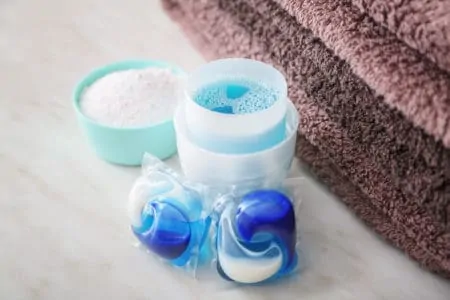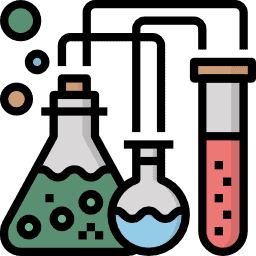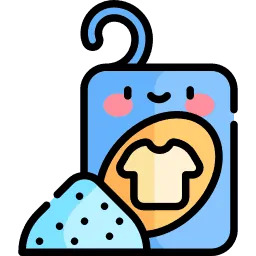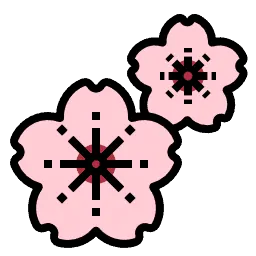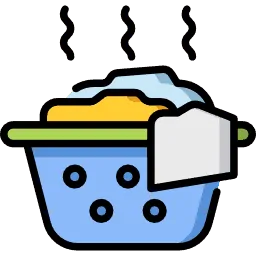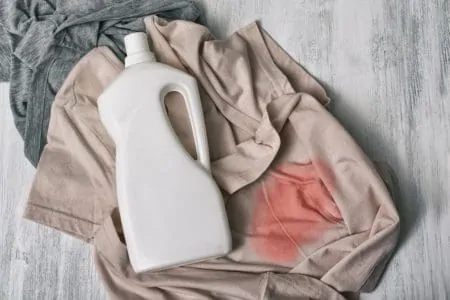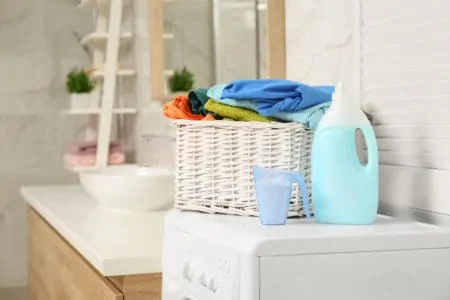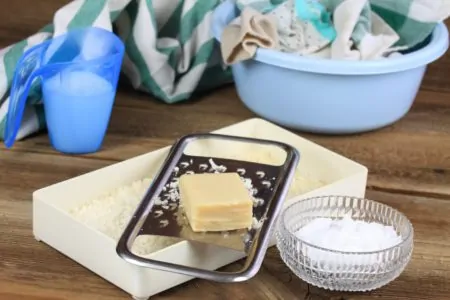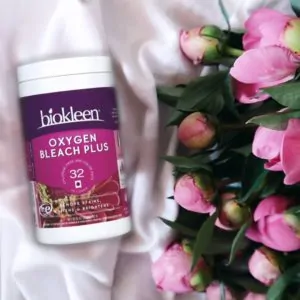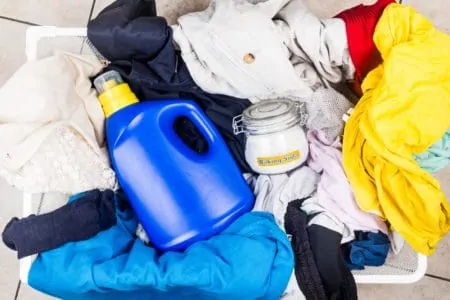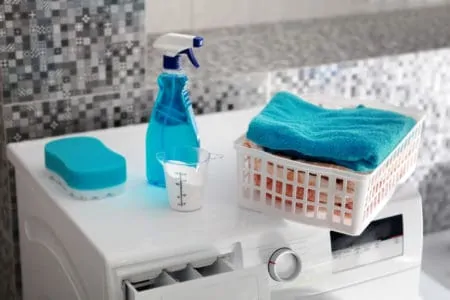Soap vs Detergent: what’s the difference? Both will get your clothes clean, but they’re made very differently. We’ll talk you through the main differences between soap and detergent, which is better, and lastly, how to make your own soap at home.
So if you’re looking for a way to make a more natural and eco-friendly cleaner, you’ve come to the right place.
Key Takeaways
- Soap is made from natural, biodegradable ingredients like oils, lye, and fats, while detergent contains synthetic chemicals such as surfactants, optical brighteners, and perfumes.
- Detergents are more effective at removing stains and brightening clothes, but soap is better for the environment and gentler on skin.
- Laundry soap is a more eco-friendly and hypoallergenic option, but may not work as well in hard water or on tough stains.
- Homemade laundry soap can be made using natural ingredients, and eco-friendly store-bought detergents are also available.
What Is Soap?
Soap is a combination of fat or oil, water, and finally, an alkali or basic salt (1). It’s been around since 2800 B.C. and can be used for washing hands, our bodies and of course, laundry.
Soap is made two different ways: either a cold process or a hot process.
The cold process takes a room-temperature lye solution and mixes it with an oil. This thickens and heats up before being poured into a mold where it solidifies into a bar of soap. It’s left to sit for a few weeks to allow excess water to evaporate before being packaged and sold to consumers.
The hot process heats all the ingredients until they’re mixed. This is a quicker way to make soap. When the soap is liquified, it’s poured into a mold. It can be packaged and sold as soon as it’s solid.
How does soap work? It removes germs and dirt. Soap molecules have one end that’s water-loving, and one end that’s oil-loving. So when you wash your hands, the soap molecules bind with both water and oil (which carries dirt and germs on our hands). When you rinse your hands, the soap removes the germs along with the water.
Soap comes in a bar form or a liquid form which is usually dispensed from a bottle with a pump. You can buy it in the store or make your own.
What Is Detergent?
Laundry detergents, unlike soap, contain more synthetic ingredients (2). The main difference is that detergents contain manmade sulfates, usually derived from petrochemicals, which cleans clothes, hair, hands, and dishes when it comes in contact with water.
But that’s not all. Detergents nowadays contain lots of other chemical ingredients that have lots of benefits. For example, some contain enzymes which are good for stain removal. Some contain bleach which is good for disinfecting. Others contain fragrances to scent your clothes. Other popular ingredients include dyes, fillers, and optical brighteners.
Like soap, detergents work by breaking up and removing grease, grime and dirt. They usually come in liquid, pod or powder form and most households are familiar with using them. In fact, they function very similarly to soap.
The detergent molecules surround grease and grime, break it up into smaller pieces and wash it away with the water. Detergents do this by reducing the surface tension of the water which breaks apart blobs of water on clothes and helps the detergent do a better job.
Soap vs Detergent: What’s the Difference?
The main difference between soap and detergent is the ingredients. Many brands label their detergent products as “soap” to appear more natural. So, the best thing to do is look at the ingredients. Soaps will be made with oils, glycerin, lye, animal fat, and fragrance oils amongst some other various biodegradable ingredients.
Detergents, on the other hand, have more synthetic chemicals, such as synthetically made sulfates (often derived from petroleum), optical brighteners, dyes, and perfumes (3). They do also contain some biodegradable ingredients, such as enzymes, but in general, the entire concoction won’t be biodegradable.
Still, it’s worth noting that there are biodegradable and eco-friendly detergents out there. But when you look at the ingredients, these are just laundry soaps! They’re labelled “detergents” because consumers automatically associate the word detergent with cleaning laundry. So it’s a good marketing technique.
We’ve made a handy table to highlight the key differences and similarities between soap and detergent.
| Characteristics | Soap | Detergent |
| Ingredients | Natural, biodegradable ingredients | A mix of natural and synthetic chemicals |
| Form | Liquid or bar | Liquid, powder, pods, |
| Biodegradable | Yes | No |
| Eco-Friendly | Yes | No |
| Toxicity | None | May contain toxic ingredients |
| Hypoallergenic | Yes | There are hypoallergenic options |
| Price | More expensive | Cheaper |
| Origin | 2800 B.C. | First world war, Germany |
Soap vs Detergent: Which Is Better?
Laundry detergent is definitely better at making clothes appear cleaner. It tackles tough stains, odors, and if it contains bleach, it can disinfect clothes.
However, it’s not super kind to the environment. Because of the synthetic ingredients, laundry detergents don’t biodegrade after they’ve been used. Plus, if they contain things like perfumes, dyes, optical brighteners and bleach, they can be very irritating on people’s skin.
On the other hand, laundry soap isn’t as effective on brightening whites and colors due its lack of optical brighteners, or removing stains. Soap is also not as effective in hard water because the soap reacts with lime and creates soap scum (4). This is usually the case with soaps that are high in alkaline, but some soaps have additional ingredients, like biological enzymes, to counteract this.
Still, it’s an eco-friendly and hypoallergenic option. These days, manufacturers make amazing laundry soap “detergents” which are almost as effective as detergents.
Top Tip
How to Make Soap at Home
If you want to make your own soap recipe, we’re here to help! This is an eco-friendly laundry powder soap recipe that is easy to make and over time, saves a lot of money.
What You Need
- 20 ounces of coconut oil.
- 10 ounces of olive oil.
- Nine ounces of distilled water.
- 4.78 ounces of 100% pure lye.
- Essential oils (optional).
- Rubber gloves.
- Plastic or ceramic bowl.
- Hand or stick blender.
- Cast iron or enameled pot.
- Wooden or plastic spatula.
- Soap molds or enameled baking pan.
- Two cups of washing soda.
- Two cups of baking soda.
- Airtight glass jar.
- Cheese grater.
Caution
Instructions
First up, we have to make the bar of soap. If you prefer, you can buy an all-natural bar of soap and skip these steps. However, if you want to get creative, let’s go through how to make your own bars of soap.
- Wearing your rubber gloves, measure out all the ingredients.
- Turn the heat on the pot and set it to low heat.
- Add the coconut oil.
- As the coconut oil begins to melt, prepare your lye solution. First, pour the water into a bowl. Slowly add in the lye, stirring with a wooden spatula as you go.
Warning
Never add water to lye as this will cause an abrupt increase in water temperature and will release dangerous fumes (6). - Set aside the solution and let it cool for 20 minutes.
- If the coconut oil has melted, add in the olive oil. Stir to combine.
- If the oil is between 120 and 130°F, turn off the heat first before slowly pouring in the lye solution, stirring as you go.
- Set your hand blender to low and begin stirring the mixture, moving in circles.
- Do this for about 10 minutes or until the mixture looks thick, like pudding.
- Put a lid on the pot and leave it for 50 minutes.
- Check it every so often. If it’s bubbling, give it a good mix.
- Turn off the heat and let the mixture cool until it is 180°F.
- Add about 30 drops of essential oils. We recommend lavender and lemon, as they smell amazing together.
- Carefully pour the mixture into soap molds. Tap the molds against the countertop to pat out any air bubbles. (If you don’t have soap molds, you can use an enameled baking pan.)
- Let it harden completely for 24 hours.
With this mixture, you should get between seven and 10 bars of soap. Now, we’ll use them for making laundry soap powder.
- Add washing soda to your airtight container.
- Add baking soda to the container.
- Grate one of your homemade soap bars very finely. If you haven’t made the soap recipe, use any kind of natural soap bar and follow the same steps.
- Add the grated soap to the airtight container.
- Put the lid on the container and shake it well to mix the ingredients together.
When it comes to washing clothes, add one to two tablespoons to your drum or detergent dispenser, depending on how dirty the clothes are. Of course, you can keep the other bars of soap for washing your hands.
How to Choose a Good Detergent
If you’re not going down the homemade laundry soap route, then how do you choose a good detergent?
FAQs
Clean Clothes
No matter what you choose — soap or detergent — you’ll still have clean clothes. While detergents do a better job of brightening, whitening, and removing stains, they’re not the most eco-friendly.
Laundry soaps, on the other hand, are made with biodegradable ingredients. You can find them online or at the store. Otherwise, why not try and make your own? It definitely makes for an interesting afternoon activity.
